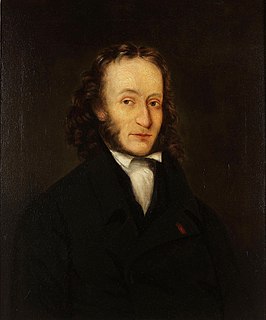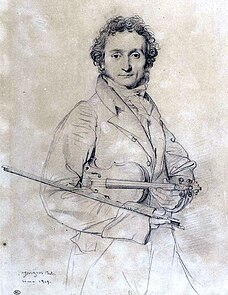
NiccolòPaganini was an Italian violinist and composer. He was the most celebrated violin virtuoso of his time, and left his mark as one of the pillars of modern violin technique. His 24 Caprices for Solo Violin Op. 1 are among the best known of his compositions and have served as an inspiration for many prominent composers.

The Rhapsody on a Theme of Paganini, Op. 43, is a concertante work written by Sergei Rachmaninoff for piano and orchestra, closely resembling a piano concerto, all in a single movement. Rachmaninoff wrote the work at his summer home, the Villa Senar in Switzerland, according to the score, from 3 July to 18 August 1934. Rachmaninoff himself, a noted performer of his own works, played the piano part at the piece's premiere on 7 November 1934, at the Lyric Opera House in Baltimore, Maryland, with the Philadelphia Orchestra conducted by Leopold Stokowski. Rachmaninoff, Stokowski, and the Philadelphia Orchestra made the first recording, on 24 December 1934, at RCA Victor's Trinity Church Studio in Camden, New Jersey. The English premiere on 7 March 1935 at Manchester Free Trade Hall also featured Rachmaninoff with The Hallé under Nikolai Malko.
A rhapsody in music is a one-movement work that is episodic yet integrated, free-flowing in structure, featuring a range of highly contrasted moods, colour, and tonality. An air of spontaneous inspiration and a sense of improvisation make it freer in form than a set of variations.
In music, variation is a formal technique where material is repeated in an altered form. The changes may involve melody, rhythm, harmony, counterpoint, timbre, orchestration or any combination of these.
Variations on a Theme of Paganini, Op. 35, is a work for piano composed in 1863 by Johannes Brahms, based on the Caprice No. 24 in A minor by Niccolò Paganini.

Caprice No. 24 in A minor is the final caprice of Niccolò Paganini's 24 Caprices, and a famous work for solo violin. The caprice, in the key of A minor, consists of a theme, 11 variations, and a finale. His 24 Caprices were probably composed in 1807, while he was in the service of the Baciocchi court.
James Ehnes, is a Canadian concert violinist and violist.

Adrien-François Servais was one of the most influential cellists of the nineteenth century. He was born and died in Halle, Belgium. He is one of the founders of the Modern Cellistic Schools of Paris and Madrid, which began with his friend Auguste Franchomme and his disciple Víctor Mirecki Larramat. His compositions are still being studied, performed and recorded all over the world.

Variations Part I&II is Croatian pianist Maksim Mrvica's third album, including his first (non-international) album, "Gestures".
Grigory Romanovich Ginzburg was a Russian pianist.
The "Carnival of Venice" is based on a Neapolitan folk tune called "O Mamma, Mamma Cara" and popularized by violinist and composer Niccolo Paganini, who wrote twenty variations on the original tune. He titled it "Il Carnevale Di Venezia," Op. 40. In 1829, he wrote to a friend, "The variations I've composed on the graceful Neapolitan ditty, 'O Mamma, Mamma Cara,' outshine everything. I can't describe it."
Sergei Rachmaninoff composed his Symphony No. 3 in A minor, Op. 44 between 1935 and 1936. The Third Symphony is considered a transitional work in Rachmaninoff's output. In melodic outline and rhythm it is his most expressively Russian symphony, particularly in the dance rhythms of the finale. What was groundbreaking in this symphony was its greater economy of utterance compared to its two predecessors. This sparer style, first apparent in the Rhapsody on a Theme of Paganini, enhances the emotional power of the work.

Variations is a classical and rock fusion album. The music was composed by Andrew Lloyd Webber and performed by his younger brother, the cellist Julian Lloyd Webber.

Émile Sauret was a French violinist and composer. Sauret wrote over 100 violin pieces, including a famous cadenza for the first movement of Niccolò Paganini's First Violin Concerto, and the "Gradus ad Parnassum" (1894).

The 24 Caprices for Solo Violin were written in groups by Niccolò Paganini between 1802 and 1817. They are also designated as M.S. 25 in Maria Rosa Moretti's and Anna Sorrento's Catalogo tematico delle musiche di Niccolò Paganini which was published in 1982. The Caprices are in the form of études, with each number exploring different skills

The Best Classics... Ever! is a compilation album released by EMI in late 2005. This compilation contains both short works and excerpts from longer works by renowned classical composers.
Musical tributes or homages from one composer to another can take many forms. Following are examples of the major types of tributes occurring in classical music. A particular work may fit into more than one of these types.

Opus is the eighth studio album of the music project Schiller created by the German electronic musician Christopher Von Deylen. The album was announced on July 1, 2013 and was released on August 30, 2013. On this album Schiller has collaborated with Russian operatic soprano Anna Netrebko, French pianist Hélène Grimaud and German classical oboist Albrecht Mayer. Opus is the first release of the new label "Panorama" by Deutsche Grammophon. The album reached in its first week number 1 of the German albums chart and number 6 in Switzerland and number 10 in Austria. These are the highest entries of Schiller in Austria and Switzerland and the fourth number-1-album of Schiller in Germany. Schiller has received a Gold award in Germany in December 2013 for 100.000 sold albums of Opus. In 2014 a reedition of the album was released: Opus - White Album.
Leonid Mikhailovich Lavrovsky (1905–1967) was a Russian ballet choreographer, most famous for choreographing the first full version of Sergei Prokofiev's Romeo and Juliet.









